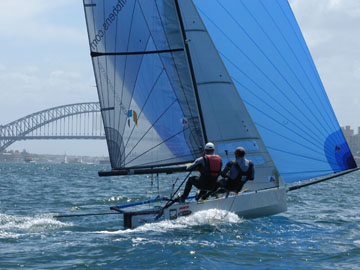 |
The Official
|
| www.sailing.org |
10 November 2009, 03:59 am
International 14 Worlds Heading To Sydney

The International 14 fleet are heading to Sydney Harbour for their Worlds this year
©Neil Patchett
CST Composites International 14 World Championship 2009
Sydney, Australia
About 200 sailors from both hemispheres are starting to sharpen their focus on the upcoming CST Composites International 14 World Championship to be sailed on Sydney Harbour this December-January.
The regatta will feature three former World Champions who will all be gunning to be the first to win two world titles. Those skippers are defending champ Archie Massey of Britain, though currently living an expatriate lifestyle in Sydney, Rob Greenhaugh of Britain who won in 2003 and Lindsay Irwin of Australia who won in 2005.
The origins of the International 14 class can be traced back to the late 1800s but the class really took shape in the early part of the 20th century. In England the class gained momentum with wealthy owners of steam yachts who would race each other in smaller sailboats.
Together with other regional dinghies the class soon developed into the leading dinghy racing class up to WWII. Meanwhile in Australia, the 14 footer was your typical skiff, attracting hard- sailing, hard-playing types who loved carrying loads of sail area around the course.
Throughout the 20th century the class spread to numerous countries and is now raced under a single I14 rule in places such as England, France, Germany, Canada, America, Japan, New Zealand and Australia. There have also been sightings in Italy.
The class rule is a progressive one that encourages development and experimentation. Consequently, there has been a never-ending quest for more improvements in speed, handling and reliability. From legendary Uffa Fox to America's Cup designer Paul Bieker, the class has always attracted design innovation.
For example, Uffa Fox broke new ground with lightweight planning hull designs in the 1930s, and while commonplace today the trapeze was first fitted in 1938 to a 14 thanks to Englishman John Winter and his boat Thunder & Lightening; Australian innovator Frank Hawkes fitted a fixed spinnaker pole and cut an asymmetric spinnaker to his boat in the early 1970s while others experimented with gybing centreboards; and in the 2000s Americas Cup designer Paul Bieker of the USA came up with the adjustable hydrofoiled rudder which allow crews to trapeze aft near the foil when sailing upwind to benefit from both lift and increased waterline length, while downwind the bow can be trimmed up for safety. It both cases, it means increased speed.
Today the boats are sophisticated and innovative craft with a powerful sailplan that reward excellence in boat handling ... just like 100 years ago.
Find our more about the CST Composites International 14 World Championship at www.i14worlds.com.
© 2013 Copyright ISAF/ISAF UK Ltd. All Rights Reserved Privacy & Cookies delivered by Sotic powered by OpenText WSM

















.png)